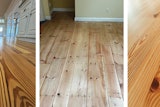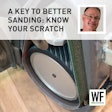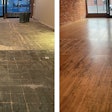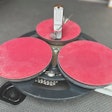
Fifty years ago, almost every new house in the United States had the same type of wood floor. For the most part, homeowners had the option of oak strip, or … oak strip. Life today as a wood flooring contractor and a homeowner is a little more complicated. It seems like practically every week a new specie is imported from the far-flung reaches of the globe. You may already have customers asking you for species you haven't even heard of. Even in the most traditional oak strip markets, at least one or two imported species have made an appearance. Like almost every other industry in the world, wood flooring has gone global, and savvy contractors need to keep up with the times.

Fifty years ago, almost every new house in the United States had the same type of wood floor. For the most part, homeowners had the option of oak strip, or … oak strip. Life today as a wood flooring contractor and a homeowner is a little more complicated. It seems like practically every week a new specie is imported from the far-flung reaches of the globe. You may already have customers asking you for species you haven't even heard of. Even in the most traditional oak strip markets, at least one or two imported species have made an appearance. Like almost every other industry in the world, wood flooring has gone global, and savvy contractors need to keep up with the times.
Not surprisingly, wood flooring from other continents can present some challenges not usually found in the lumber from our own backyards. It may be so hard that it burnishes instead of sands, or the finish you're accustomed to using every day may turn the wood a funky color. The dust of some species may make you violently ill. You need to be aware of these and many other details before going out to tackle your first exotic species job.
Background Checks
Working with exotics requires that you go over some special considerations with the client before beginning the job. First, get client approval on wood you intend to use with the finish that is to be applied. Samples should be made for a job of any species of wood, whether domestic or imported, but it is particularly important with exotics, many of which look significantly different depending on the finish applied and may not be compatible at all with certain finishes. Also, some woods such as teak and Brazilian cherry/jatoba are very photosensitive; with age and exposure to light, their color will change considerably. Be sure to show both a sample of the new wood and a sample of aged boards. This helps the client select matching trim and cabinetry and also helps avoid surprises a few months down the road. If the client suggests staining the floor, try to steer him toward a species that is naturally the color he wants. Staining an exotic defeats the purpose of buying a more expensive, unusual wood, and, like maple, many species simply don't take stain well. Not infrequently, contractors use red stain on Brazilian cherry in an attempt to meet designer or customer expectations, but this stain will fade over time.
In addition to color, there are several other appearance issues about which the client should be educated. One is dimensional stability (or lack thereof). All woods demonstrate some movemen twith changes in humidity levels, but many imported woods show more drastic changes—and therefore bigger cracks—than a typical American oak strip floor. Climate control is especially important for these woods. Also, the dark colors of many exotic species show imperfections in the floor more than lighter species of wood do, so more than ever, try to downplay the misconception that a wood floor will have a perfect piano-top finish.
Working with exotics may also present a health risk for the client. The wood itself is inert, but the dust of many imported woods can cause skin or respiratory irritation, or more severe allergic reactions. The safest bet is to make sure the family is out of the home when an exotic species is being sanded, even if it's only in one room. Hanging plastic and using dust containment systems help limit the dust, but the finest dust still settles on walls and throughout the home, even after the job is done. The dark color of many exotics will make the dust especially visible—santos mahogany, for example, will leave a trace of red dust on walls. The dust of some species may even stain wall coverings and window treatments. Brazilian walnut/ipé may leave green stains. To be safe, be sure that all surfaces are covered. People with respiratory problems or severe allergies may want to wait to reenter the home until a professional cleaning crew has been through the house.
Finally, remember that by using exotic woods, you are offering a product that many contractors can't or won't work with. Be sure your charges are commensurate with your special skills and products.
Hard, But Not Fast
Just as the home owners need to be aware of the potential health problems with dust, so do the workers on the job site. Respiratory protection should always be worn, and as little skin as possible should be exposed. MSDS (Material Safety Data Sheets) should be present on the job site for each imported species. Contact the wood supplier for any safety information it may have regarding the wood, as well as recommendations for sanding and finishing.
Before sanding even begins, check the moisture content of the floor. It should have been acclimated appropriately before installation (exotics may take weeks longer than domestic species to acclimate), but check at this stage, also. The moisture content of the floor will affect how it sands—the drier it is, the easier it will be. Don't attempt to sand wood with a moisture content that is too high. Also, to ensure your readings are correct, adjust your moisture meter for the species you're working with.
If the moisture content is within an acceptable range, sanding can begin, but keep in mind that sanding an exotic species may be an entirely different animal than the oak you're used to. For example, the most common imported species, Brazilian cherry/jatoba, has a hardness rating that is 82 percent harder than northern red oak. Most exotics, if not 82 percent harder, are significantly harder than oak and require special considerations.
Be careful when selecting the first grade of abrasive—don't make the common mistake of beginning with too fine a grit, which will simply smooth off the tops of the imperfections in the floor. Many professionals now recommend that the first cut with the big machine be done on a 7 to 15 percent angle off the direction of the flooring. The angle helps cut the floor flat; then the floor can be straight-sanded again with the same grit of paper. Not skipping a grit in the grit sequence (going with a sequence of 40,60, 80 and 100, for example, instead of 40,60 and 100) may be necessary to get out the scratches left by the previous grit. With these very hard, dense woods, abrasives quickly become dull, and they may begin to burnish the floor instead of sanding it. To successfully flatten the floor, sandpaper and screens must be kept sharp (they will need to be changed frequently), and the floor must be cleaned thoroughly between each cut.
Oily imported woods such as Australian cypress and teak from southeast Asia also require a healthy stockpile of abrasives. Although the woods are not very hard (teak is soft enough that it may even show wheel marks from the big machine), they make a gooey mess of abrasives as their oils and sawdust load up the sandpaper and screens. Beginning with a rough-enough grit should minimize loading. Again, keep the abrasives sharp by changing them frequently. The knots in Australian cypress may cause the floor to become dished out around them, so using sharp paper is critical to avoid leaving little bumps allover the floor. Attempting to sand such species with too fine a grit will exaggerate the dishing effect, as well.
Dishing out is also a common frustration when working with borders and inlays. Within one medallion, the species can vary greatly in hardness and grain direction, yet they somehow need to all be sanded to the same level. Experienced sanders achieve that by cutting on an angle with the big machine and using a hardplate to flatten the floor (orbital sanders and three-disc style machines also work well with various species and grain patterns). Many contractors get in trouble by concentrating too much on screening, which tends to dish out soft grain. A better method is to flatten the floor with a hardplate and then screen the field, only briefly touching on the borders and inlay. Next, go back over the inlay and borders by hand-scraping and hand-sanding.
Using filler on imported species can require some extra thought. Just because that filler matches the color of the floor today doesn't mean it will tomorrow, next month or next year. It's up to you to know how photosensitive the species is and find a filler that will match the floor's color in the long run. That may mean buying a custom color. Or, some contractors use the old time method of mixing their own lacquer oil filler with dust from the actual floor—ensuring that the filler will darken or change color just as rest of the floor will.
The biggest problem that first-time exotic flooring contractors run into is not being careful enough with their sanding jobs. Just as using dark stain highlights every gouge and edger mark on an oak floor, the naturally dark color of many exotics tends to show every sanding imperfection. Additionally, unlike an oak floor, many imported woods have very little grain definition, leaving little to disguise errors by a sloppy sander. Checkwith finish manufacturers for which grit to end on—oil-modified finishes will typically require a lower grit than waterbased finishes, which need a smoother, more burnished surface.
Be Sure They Agree
Before you even think of putting finish on a species you haven't worked with before, it is vital that you test it on a sample (ideally, you already did this to show it to your customer). Weird reactions between different types of finishes and certain species of exotic woods are not unusual. Some pitfalls to watch out for include the finish taking an exceptionally long time to dry, the finish changing the color of the wood, or the finish not having a uniform sheen.
Finish manufacturers always frown upon using different companies' products on the same floor, and it is especially risky to mix products when dealing with touchy exotic woods. To be safe, use the "system" approach of the same company's sealer and topcoat finishes (and follow their directions carefully). No matter which finish you're using, always use a sealer. Also, factor in extra drying time after each coat. Most exotics are very dense woods and don't absorb finish as readily as most domestics do.
Which type of finish to use is entirely up to the contractor—four people who work with exotics every day may swear by four different types of finishes. However, all finishes have their own considerations that need to be taken into account.
Some contractors feel that oil-modified finishes are best at highlighting the rich tones of exotic species, but caution must be taken with dry times—species such as Brazilian walnut/ipé have been known to take an entire month to dry when coated with oil-modified finish. Making that sample can help you determine how much time is necessary for a successful job and if the color is appealing. Occasionally oil modified finishes will cause a reaction changing the color of the wood; for example, Brazilian walnut/ipé may turn blood red when coated with polyurethane.
The most common exotic, Brazilian cherry/jatoba, is frequently coated with oil modified polyurethane, but you may want to be particularly careful about such jobs. Occasionally, coating Brazilian cherry with poly causes white spots or specks to appear, and sometimes the end joints between boards turn white. To prevent this, some contractors buff in a clear oil sealer or neutral stain, then use several coats of satin polyurethane buffed in with a white pad.
Some contractors prefer to use water based finishes on exotics, believing that the water-based products, especially those with a UV blocker, tend to hold the color of the wood better. Dry times will also be shorter with these products. Finishers should be particularly careful when applying water base over dark woods, such as merbau or santos mahogany, because areas with drips, puddles or extra finish may show as darker areas on the floor. If you would like to use an amberizer to give the look of a poly in a waterbase, try it on a sample first—amberizers are designed to be compatible with the colors of lighter American woods as opposed to the dark shades of most imported species, and may not give the effect you are looking for.
Moisture-cure urethane products are used with success on many exotics, and are noted for bringing out rich colors in the woods. Again, check dry times. Also, test to see if the product looks uniform on the species you want to use. For example, most contractors will use only a gloss-sheen moisture-cure on dark woods because the satin sheen's flattening agent tends to show applicator start and stop marks.
Like oil-modified and moisture-cured finishes, conversion varnish finishes bring out rich, deep colors in the woods (each type of finish will change the color slightly, however, so make a test and be sure to not use different finishes on different areas of the same job site). Low sheens in conversion varnishes work particularly well over exotics.
Some woods may cause problems. Many contractors get in trouble by concentrating too much on screening, which tends to dish out soft grain with any type of finish. Oily woods such as teak may need to be treated with the appropriate solvent (ask your finish manufacturer what to use) before being coated. Or, many finish manufacturers recommend that the floor simply be screened and then cleaned and coated immediately afterward, before the oils in the wood have a chance to work back up to the surface. On Australian cypress floors, the knots may stay sticky after the rest of the floor has dried.
Just as sanders need to take extra precautions when working with multiple species in borders and inlays, finishers should be aware of the products they're working with. Some exotics—including padauk, purpleheart and jarrah—may "bleed" their color onto neighboring woods when finished. The dust of those species is spread onto the boards of lighter woods, such as maple or beech, giving them a pink cast. Contractors recommend several methods to avoid this unsightly phenomenon. Some recommend vacuuming extremely well (not tacking, which would pull the dust out across the floor), then using a fine applicator or small bristle brush to apply a light finish coat over just the border or inlay, then coating the entire floor. Some finish manufacturers offer their finish in a spray can that may be used to accomplish the same thing. Using a neutral stain or sealer to first seal the species susceptible to contamination, allowing them to dry and then coating the rest of the floor is also a method that has been used with success.
If at any point in the job the floors need to be covered up, be sure that every square inch of the floor gets covered. Again, many imported woods are very photosensitive, and may later show a line where the edge of the cardboard was laid down three weeks earlier. Likewise, try to do an entire job at once. Don't do half the job and comeback two weeks later to do the other half, only to discover that you now have two differently colored wood floors of the same species nicely contrasted side-by-side. These scenarios can happen with both job-site finished and prefinished flooring.
No matter which species you're working with—whether it's from the Congo Basin of Africa or the jungles of Thailand—the most important thing is to experiment with it in your shop, not on your customer's floor. Exotic species offer some of the most brilliant colors and gorgeous wood available in nature, but it's up to you to make them look fabulous in your customer's home.
Under Your Skin
Most woods — domestic as well as imported — contain chemical compounds that are irritating to some individuals during cutting or sanding. While wood alone is not hazardous, skin contact with or inhalation of wood dust can be. Installers, because of their repeated exposure to sanding and sawdust, need to be aware of possible allergic reactions, including contact dermatitis and respiratory problems. Once finish is applied, wood is basically inert. Respiratory reactions can include sneezing or breathing problems. Contact dematitis can result in itching or, in rare cases, painful rashes. As an individual becomes sensitized to a wood over time, these reactions can get stronger.Preventive Measures• Have good dust-collection apparatus attached to all sanding machines.• Wear long-sleeve shirts and hats to avoid skin exposure.• Shower after being exposed to dust to minimize the skin-irritant potential.• Wear a good dust respirator to mitigate respiratory dangers.• To test your skin’s allergic reactive potential prior to working with large quantities of dust, perform a skin-patch test. Take a small quantity of fine dust from the wood being used and place it under an adhesive bandage on the inside of your forearm. Leave it in place for 24 hours and then remove. If any serious skin irritation is present, do not proceed.

































